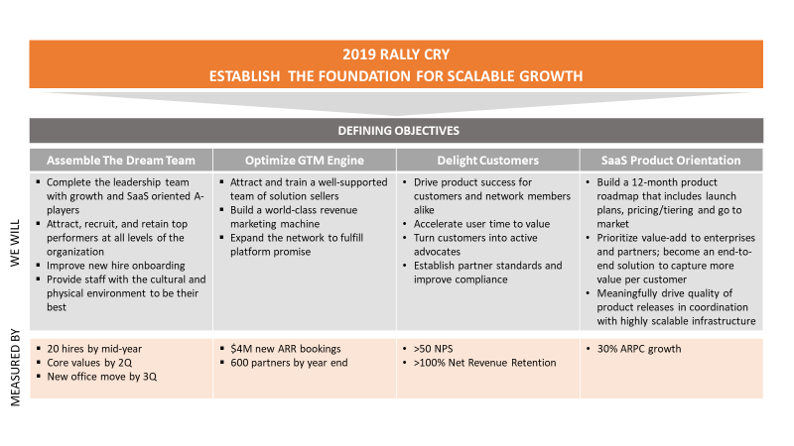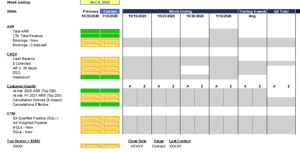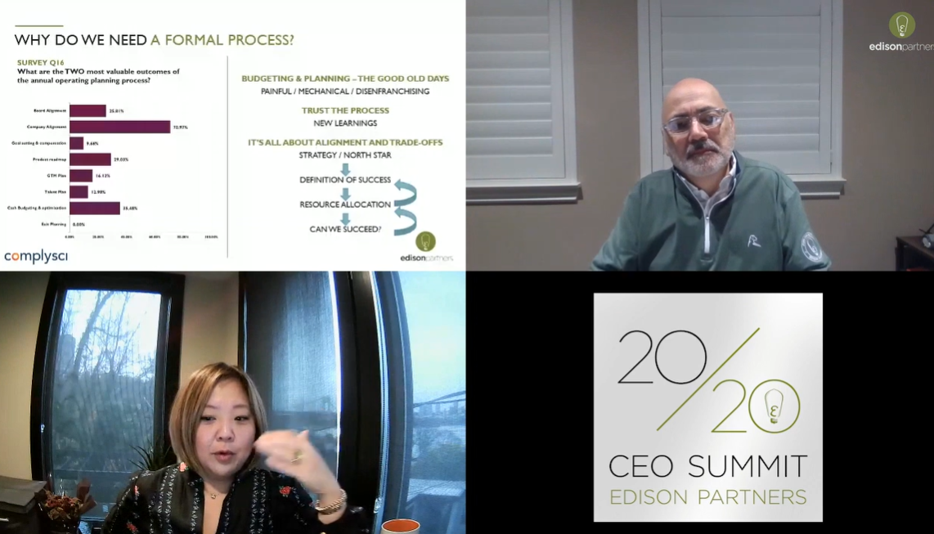It’s that time of year, and by now, you probably have at least the draft of a “plan” in place for the new year. But is that plan a financial one or an operating one? If it’s a budget in a spreadsheet developed based on discussions between the CEO and CFO, guess what? That’s not an annual operating plan (AOP). The AOP should drive the financials; it provides the necessary glue that aligns the organization on strategy, measurements of success, and the resources necessary to execute. AOP development is an important muscle that leaders build over time, and a well-run process not only delivers on the alignment objective, but also builds confidence with your team and your board that goals can be achieved.
During our recent CEO Summit, ComplySci’s Amy Kadomatsu and Jean-Marc Levy shared their method for charting where they are going and how they are going to get there on an annual basis. The key ingredients for their AOP process are as follows.
-
One Plan. There’s one annual plan -- not one for management and one for the board… and no ‘base case,’ ‘expected case,’ and ‘optimistic case.’ A single blueprint ensures absolute alignment up and down the organization and with the board in order to increase the likelihood of successful execution. The exception to this rule can be the bookings number, which may be higher than the core plan shared between management and the board. And, of course, in this time of COVID, there should be a separate cash plan that prepares for worst cases.
-
Urgency & Iteration. For ComplySci, the team establishes and trusts the process with an AOP calendar that starts in August and includes weekly check-ins to iterate on specific topics. A little over-management is goodness because it helps manage course corrections, eliminate surprises, and ultimately, alignment at every step. Hard deadlines and attendee requirements drive urgency, and board related milestones are the ultimate tool to further emphasize both urgency and accountability.

-
Data. Data. More Data. Brutal honesty is a guiding principle for ComplySci’s AOP process, and that is achieved by working with a reliable data set. A comprehensive view of the business via metrics helps the team face the facts, identify the most telling, most critical metrics, and shines a bright light on the “what we should not be doing” items. Many startup and growth-stage companies have their fingers on some, but not all of the data needed, which is probably the most common reason why corners are cut in the annual planning process and companies start the year with too many priorities and initiatives. Gathering and distilling the necessary data is simply a must – just one of those “eat the crust first” things.
-
The Rally Cry. The combination of #1-3 above enables prioritization of the key drivers and associated 6-10 key metrics moving the needle for the business. Distilling this into a one-page Rally Cry makes it real for every employee. Functional one-page plans further cascade the objectives and measurements down into the organization. Watch Amy and Jean-Marc’s session for ComplySci’s Rally Cry. Below is another illustrative example.

-
Execution & Accountability. Once the company Rally Cry and functional plans on a page (ComplySci calls them POAPs) are complete. Adoption, execution and accountability of the POAPs happen through quarterly goal-setting at both the departmental and
 individual level. At ComplySci, the management team reviews KPIs weekly in a meeting where leaders are expected to come prepared with questions, insights and actions. Further, the company's board is actively leveraged as a weapon to help the team drive results.
individual level. At ComplySci, the management team reviews KPIs weekly in a meeting where leaders are expected to come prepared with questions, insights and actions. Further, the company's board is actively leveraged as a weapon to help the team drive results.
To watch the full CEO Summit session with Amy and Jean-Marc, click Beyond the Spreadsheet: Creating Annual Operating Plans That Drive Results. There’s still time to optimize your AOP before we reach the new year!
(And in preparation for January’s board meeting, you might also enjoy the Dos, Don’ts, Great Ideas, and Pitfalls of Reviewing Annual Operating Plans with Your Board).


.png)